Related Research Articles

Kanji are the logographic Chinese characters taken from the Chinese script used in the writing of Japanese. They were made a major part of the Japanese writing system during the time of Old Japanese and are still used, along with the subsequently-derived syllabic scripts of hiragana and katakana. The characters have Japanese pronunciations; most have two, with one based on the Chinese sound. A few characters were invented in Japan by constructing character components derived from other Chinese characters. After the Meiji Restoration, Japan made its own efforts to simplify the characters, now known as shinjitai, by a process similar to China's simplification efforts, with the intention to increase literacy among the common folk. Since the 1920s, the Japanese government has published character lists periodically to help direct the education of its citizenry through the myriad Chinese characters that exist. There are nearly 3,000 kanji used in Japanese names and in common communication.

The Kansai region or the Kinki region lies in the southern-central region of Japan's main island Honshū. The region includes the prefectures of Nara, Wakayama, Kyoto, Osaka, Hyōgo and Shiga, often also Mie, sometimes Fukui, Tokushima and Tottori. The metropolitan region of Osaka, Kobe and Kyoto is the second-most populated in Japan after the Greater Tokyo Area.

The Kansai dialect is a group of Japanese dialects in the Kansai region of Japan. In Japanese, Kansai-ben is the common name and it is called Kinki dialect in technical terms. The dialects of Kyoto and Osaka are known as Kamigata dialect, and were particularly referred to as such in the Edo period. The Kansai dialect is typified by the speech of Osaka, the major city of Kansai, which is referred to specifically as Osaka-ben. It is characterized as being both more melodic and harsher by speakers of the standard language.

Hankyu Corporation (阪急電鉄株式会社, Hankyū Dentetsu kabushiki gaisha, lit. 'Hankyu Electric Railway Stock Company'), trading as Hankyu Railway (阪急電鉄, Hankyū Dentetsu, lit. 'Hankyu Electric Railway'), is a Japanese private railway company that provides commuter and interurban service to the northern Kansai region and is one of the flagship properties of Hankyu Hanshin Holdings Inc., in turn part of the Hankyu Hanshin Toho Group (which includes H2O Retailing Corporation and Toho Co., the creator of Godzilla). The railway's main terminal is at Umeda Station in Osaka. The signature color of Hankyu cars is maroon.
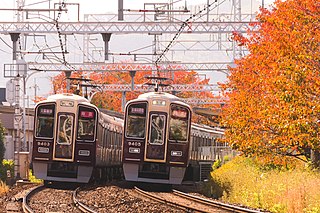
The Hankyu Kyoto Main Line is a railway line in Japan operated by the private railway operator Hankyu Railway. It connects Osaka-umeda Station in Osaka and Kyoto-kawaramachi Station in Kyoto.

Jūsō Station is a railway station in Jūsō, Yodogawa-ku, Osaka, Japan, operated by the private railway operator Hankyu Railway. The six-track trunk line from Umeda Station diverges into the three double tracks of the Hankyu Kobe Line, the Hankyu Kyoto Line and the Hankyu Takarazuka Line at this station. The area surrounding the station is an extensive shopping and entertainment district.

Kyōto Station is a major railway station and transportation hub in Kyōto, Japan. It has Japan's second-largest station building and is one of the country's largest buildings, incorporating a shopping mall, hotel, movie theater, Isetan department store, and several local government facilities under one 15-story roof. It also housed the Kyōto City Air Terminal until August 31, 2002.
Sino-Japanese vocabulary, also known as kango refers to Japanese vocabulary that originated in Chinese or was created from elements borrowed from Chinese. Some grammatical structures and sentence patterns can also be identified as Sino-Japanese. Sino-Japanese vocabulary is referred to in Japanese as kango (漢語), "Chinese words".
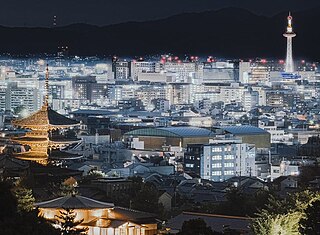
Keihanshin is a metropolitan region in the Kansai region of Japan encompassing the metropolitan areas of the cities of Kyoto in Kyoto Prefecture, Osaka in Osaka Prefecture and Kobe in Hyōgo Prefecture. The entire region has a population of 19,302,746 over an area of 13,228 km2 (5,107 sq mi). It is the second-most-populated urban region in Japan, containing approximately 15% of Japan's population.
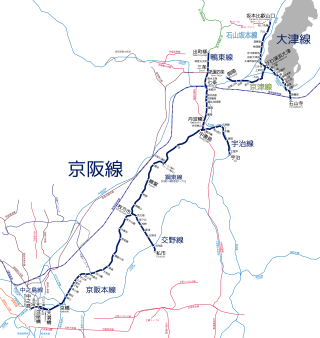
The Keihan Electric Railway Company, Ltd., known colloquially as the "Keihan Dentetsu" (京阪電鉄), "Keihan Densha" (京阪電車), or simply "Keihan" (京阪), is a major Japanese private railway operator in Osaka, Kyoto, and Shiga Prefectures. The transit network includes seven lines; four main lines with heavy rolling stock, two interurban lines, and a funicular railway.
In Japanese, Keihan may refer to:

In modern Japanese, ateji principally refers to kanji used to phonetically represent native or borrowed words with less regard to the underlying meaning of the characters. This is similar to man'yōgana in Old Japanese. Conversely, ateji also refers to kanji used semantically without regard to the readings.
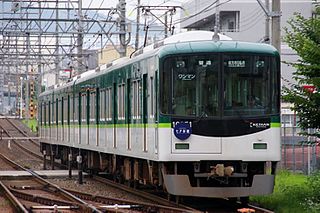
The Keihan Katano Line is a 6.9 km railway line in northern Osaka Prefecture, Japan, operated by the private railway company Keihan Electric Railway. It connects Hirakatashi Station on the Keihan Main Line with Kisaichi Station.

The Hankyu Arashiyama Line is a railway line in Kyoto, Japan, operated by private railway operator Hankyu Railway. It connects Katsura and Arashiyama on the west side of the city, linking the area along the line to the Hankyu Kyoto Main Line that extends east to central Kyoto and south to Osaka. The line is 4.1 km long.

The Hanshin Expressway is a 239.3-kilometer-long (148.7 mi) network of expressways surrounding Osaka, Kobe and Kyoto, Japan. Operated by Hanshin Expressway Company, Limited, it opened in 1962.
Hanshin, derived from the second kanji from Osaka (大阪) and the first kanji from Kobe (神戸), refers generally to Osaka, Kobe, and the surrounding area in the Kansai region of Japan.

The Hankyu Senri Line is a railway line in Osaka Prefecture, Japan, operated by Hankyu Railway. It commenced operation in 1921 and was completed on March 1, 1967. Through trains operate to and from the Hankyu Kyoto Line and the Osaka Municipal Subway Sakaisuji Line.
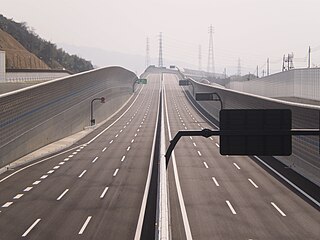
The Second Keihan Highway, also called as Daini-Keihan Road, is a national highway and 6-laned Regional High-Standard Highways (expressway) in Japan, leading from Fushimi-ku, Kyoto through Kansai Science City to Kadoma, Osaka. This road is a bypass of Japan National Route 1.
References
- 1 2 3 4 Elisa Mattiello, "An Introduction to English Slang: A Description of Its Morphology, Semantics and Sociology", 2008, ISBN 8876991131, pp. 146-148
- ↑ Bauer, Laurie (1983). English Word-Formation. Cambridge Textbooks in Linguistics. Cambridge University Press. p. 233. ISBN 0521284929.
- ↑ Larissa Ryazanova-Clarke, Terence Wade, The Russian Language Today, 2002, ISBN 0203065875, p. 49